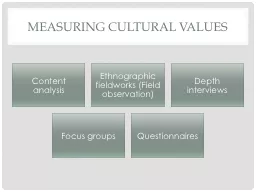PPT-Getting along across cultures: cultural values,
Author : lois-ondreau | Published Date : 2016-09-17
communication and conflict styles face and relationship management Rebecca L Oxford PhD ITESOL Oct 18 2014 Getting along across c ultures This exciting presentation
Presentation Embed Code
Download Presentation
Download Presentation The PPT/PDF document "Getting along across cultures: cultural ..." is the property of its rightful owner. Permission is granted to download and print the materials on this website for personal, non-commercial use only, and to display it on your personal computer provided you do not modify the materials and that you retain all copyright notices contained in the materials. By downloading content from our website, you accept the terms of this agreement.
Getting along across cultures: cultural values,: Transcript
Download Rules Of Document
"Getting along across cultures: cultural values,"The content belongs to its owner. You may download and print it for personal use, without modification, and keep all copyright notices. By downloading, you agree to these terms.
Related Documents














